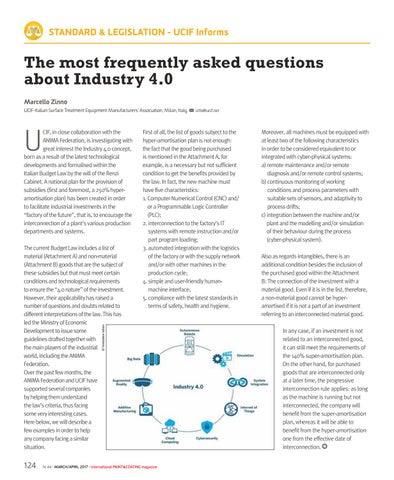STANDARD & LEGISLATION - UCIF Informs
The most frequently asked questions about Industry 4.0 Marcello Zinno UCIF-Italian Surface Treatment Equipment Manufacturers’ Association, Milan, Italy
U
CIF, in close collaboration with the ANIMA Federation, is investigating with great interest the Industry 4.0 concept, born as a result of the latest technological developments and formalised within the Italian Budget Law by the will of the Renzi Cabinet. A national plan for the provision of subsidies (first and foremost, a 250% hyperamortisation plan) has been created in order to facilitate industrial investments in the “factory of the future”, that is, to encourage the interconnection of a plant’s various production departments and systems.
First of all, the list of goods subject to the hyper-amortisation plan is not enough: the fact that the good being purchased is mentioned in the Attachment A, for example, is a necessary but not sufficient condition to get the benefits provided by the law. In fact, the new machine must have five characteristics: 1. Computer Numerical Control (CNC) and/ or a Programmable Logic Controller (PLC); 2. interconnection to the factory’s IT systems with remote instruction and/or part program loading; 3. automated integration with the logistics of the factory or with the supply network and/or with other machines in the production cycle; 4. simple and user-friendly humanmachine interface; 5. compliance with the latest standards in terms of safety, health and hygiene.
© Fondazione Edison
The current Budget Law includes a list of material (Attachment A) and non-material (Attachment B) goods that are the subject of these subsidies but that must meet certain conditions and technological requirements to ensure the “4.0 nature” of the investment. However, their applicability has raised a number of questions and doubts related to different interpretations of the law. This has led the Ministry of Economic Development to issue some guidelines drafted together with the main players of the industrial world, including the ANIMA Federation. Over the past few months, the ANIMA Federation and UCIF have supported several companies by helping them understand the law’s criteria, thus facing some very interesting cases. Here below, we will describe a few examples in order to help any company facing a similar situation.
124
info@ucif.net
N. 44 - MARCH/APRIL 2017 - international PAINT&COATING magazine
Moreover, all machines must be equipped with at least two of the following characteristics in order to be considered equivalent to or integrated with cyber-physical systems: a) remote maintenance and/or remote diagnosis and/or remote control systems; b) continuous monitoring of working conditions and process parameters with suitable sets of sensors, and adaptivity to process drifts; c) integration between the machine and/or plant and the modelling and/or simulation of their behaviour during the process (cyber-physical system). Also as regards intangibles, there is an additional condition besides the inclusion of the purchased good within the Attachment B: The connection of the investment with a material good. Even if it is in the list, therefore, a non-material good cannot be hyperamortised if it is not a part of an investment referring to an interconnected material good. In any case, if an investment is not related to an interconnected good, it can still meet the requirements of the 140% super-amortisation plan. On the other hand, for purchased goods that are interconnected only at a later time, the progressive interconnection rule applies: as long as the machine is running but not interconnected, the company will benefit from the super-amortisation plan, whereas it will be able to benefit from the hyper-amortisation one from the effective date of interconnection.
